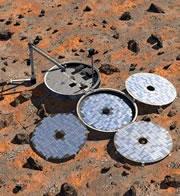 The Beagle has landed: an artist's impression of the instruments as they should have been on Mars.ESA/Denman productions
The Beagle has landed: an artist's impression of the instruments as they should have been on Mars.ESA/Denman productionsThere's life in the old dog yet: plans are afoot to use duplicates of the Beagle 2's instrumentation to assess conditions for a future Moon base.
The British Beagle 2 lander was due to touch down on Mars at Christmas 2003, but contact was lost in the last moments as the craft plummeted towards the red planet, and it hasn't been heard from since.
Now a team including Everett Gibson and David McKay from NASA's Johnson Space Center in Houston, Texas, and the original Beagle 2 team leader Colin Pillinger of the Open University in Milton Keynes, UK, say they have plans to re-use the same technology from that ill-fated craft in a future mission to the Moon.
The group proposes that the same instrumentation be packaged up in a streamlined payload that could hitch a ride on another mission — to the Moon or elsewhere. This stripped-down version wouldn't need the vacuum system or hard shell of the original mission, and so would weigh between 15 and 20 kilograms, Gibson says, compared with 69 kilograms for the original Beagle 2. Each such Beagle pup would cost less than $20 million, says Gibson. "It's a low-cost approach to answer some fundamental questions," he says.
The group has asked NASA to fund the project, Gibson and McKay this week told the Lunar and Planetary Science Conference in League City, Texas.
Best package
The Beagle science package includes a mass spectrometer called the Gas Analysis Package (GAP) instrument. "It's the best analytical tool to answer questions about what the polar volatiles are on the Moon," says Gibson. It also had a digging arm 2 metres long, which would be useful for getting soil samples — although it's unclear how deep it could go on the Moon.
The Beagle instruments have all been tested for flight, and the GAP is the most sophisticated mass spectrometer ever built for Mars or the Moon, Gibson says.
Ben Bussey, from the Applied Physical Laboratory in Laurel, Maryland, is part of a team using radar to map lunar ice deposits, with their mission set to fly in 2008. Having a mass spectrometer that could be sent to the surface to analyse any ice deposits spotted would be very useful, he says. Other teams are thinking of ways to check on polar volatiles from the surface, but there are no firm plans as yet.
ADVERTISEMENT
Landing has always been the tricky bit for Beagle. "Beagle 2 was very cheap, but it didn't work," notes Bussey. But the Beagle Moon team says it won't even attempt a landing on their own this time — they only plan to attach themselves to another mission that is bound for the surface. That should work much better, says McKay.
Checking out the suitability of the Moon for habitation should be a priority, says Gibson. "We owe it to civilization to investigate," he says. McKay even goes so far as to suggest that the instrument could be useful to track long-term changes to the Moon from human colonization — if and when that ever happens.
Visit our forbeagle.html">newsblog to read and post comments about this story.
